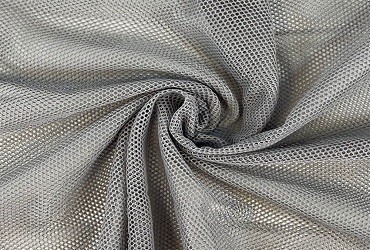Mesh fabric
Mesh fabric comes in several kinds, but this fabric is distinguished by its lightweight heaviness and porous texture. Unlike other fabrics, which have tightly knit textures, a mesh is knitted loosely, resulting in hundreds of small holes in each mesh garment. Mesh fabric is often composed of polyester, nylon, or spandex. All those are synthetic materials that have a lengthy lifespan. Moreover, the mesh can be fashioned of metal to give the cloth a gleaming effect.
Although all mesh textiles have a mesh-like structure, their weight, thickness, color, and finish can vary. The material is also available with finer or coarser perforations.
History
Mesh cloth was invented in 1888 by a British textile owner, popularized in the 1980s by sportswear manufacturers, and has been a popular item in the fashion industry for many years. It's stretchy, sturdy, breathable, and... essential for every clothes designer.
Mesh has been utilized for centuries, for example, every form of the net is constructed of mesh, and this material has also been used to build objects such as hammocks. But it was at the end of the nineteenth century that textile inventors began employing mesh for clothing. While British mill owner Lewis Haslam was out on a stroll with his aunt in chilly weather, he had the idea to utilize mesh for cloth. He observed that her gloves had holes in them, but when he asked her about them, she claimed that her hands were still warm.
Mesh is nearly always constructed of synthetic materials such as polyester and nylon. Several fabric specialists argue that the thread style used in prominent brands like Lacoste's Polo shirts is a sort of mesh.
How Does Mesh Fabric Produce?
Mesh fabric is manufactured using a variety of different ways depending on the type of fiber used. While nylon and polyester are quite similar in many aspects, polyester was invented a few years after nylon, therefore means that this synthetic material is manufactured using substantially more modern manufacturing procedures.
Despite the procedures utilized to create these two types of fabric fibers differ, they both begin with the refining of petroleum oil. Polyamide monomers are then isolated from this oil and treated with various types of acid to produce polymers.
After being reacted, these polymers are normally solid, and they are melted and driven through spinnerets to form polymer strands. These strands can then be put onto spools and delivered to textile production plants to be produced into mesh fabric.
Most mesh fabric makers will color their polyester or nylon strands before weaving them into the fabric. Textile makers may then weave these fibers in a variety of ways to generate varied meshes. Many meshes, for example, adhere to a fundamental square design that has shown to be useful over thousands of years. Yet, more modern meshes, like tulle, may be knitted with a tetragonal lattice.
What is the price of mesh fabric?
The cost of mesh fabric is determined by both the type of material used and the style of mesh woven. For example, undyed mesh woven in a basic square design is very affordable, but brightly-dyed mesh woven in a hexagonal Tulle pattern costs more to create, making it more expensive to garment manufacturers and the end consumer.
Types of Mesh Fabric
Polyester mesh
Polyester is utilized in most meshes used in sportswear and sporting gear. This fabric is extremely light and has a significant capacity to wick moisture. Polyester mesh, unlike other types of cloth, does not become clogged with sweat and is extremely breathable.
Nylon mesh
Among the many recognized uses of nylon mesh is in beekeeping veils. This mesh is less usually used to produce garments and is more commonly used to make tent screens and laundry bags. Nonetheless, nylon mesh is occasionally used to manufacture lightweight clothes such as evening gowns.
Power net
This mesh fabric has a reasonably thick weave. Power net is often used in shaping garments such as top tights, bras, and control slips, and the terms "power net" and "power mesh" may be used interchangeably in some circumstances.
Mesh fabric characteristics
Mesh is good for athletics, dancewear, and shoes due to its breathability like for example “Yeezy" shoes. Yet, the material has certain unique properties. That's the way it is:
- Strong
- Wrinkle free
- Easy to maintain
- Water-resistant
- Very elastic
Clothing made from mesh fabric
Mesh fabric is suitable for combining with other non-transparent textiles due to its translucent, mesh-like appearance. Also, the cloth is simple to cut and sew.
To avoid wrinkles while stitching, wash the cloth before processing.
To cut mesh cloth, only use sharp scissors.
Use the proper yarn: synthetic yarn for polyester or nylon mesh textiles, and cotton yarn for other mesh fabrics.
Instead of straight stitches, using zigzag stitches.
What Is the Environmental Effect of Mesh Fabric?
To some extent, the environmental effect of mesh fabric is determined by the materials used to make it. Yet, because the mesh is usually always constructed of synthetic materials, it's simple to conclude that it has a significant detrimental influence on the environment. There is some report that this fabric was dumped in a river and fish died because of that.
Regardless of whether these materials are properly disposed of, they will ultimately reenter the environment. There is no way to prevent this pollution once polyester or nylon materials are manufactured; the only way to mitigate this effect is to create less clothing made with these fibers.
Conclusion
Mesh textiles have been around for a long time and are still used for a variety of items and clothes.
